| OCTOBER 2019 |
| Kabukiza (T˘ky˘) |  |
| Dates | 2 ~ 26 October 2019 Geijutsusai Jűgatsu ďkabuki National Arts Festival October Grand Kabuki |
| MatinÚe | |
| Evening |
Sannin Kichisa Tomoe no Shiranami Futari Shizuka |
| Casting |
Living National Treasure Onoe Kikugor˘, Living National Treasure Band˘ Tamasabur˘, Nakamura Tokiz˘, Nakamura Senjaku, Kataoka Ainosuke, Onoe Sh˘roku, Ichikawa Sadanji, Ichikawa Danz˘, Band˘ Rakuzen, Nakamura Karoku, Band˘ Minosuke, Onoe Matsuya, Ichikawa Sai'nyű, Band˘ Hikosabur˘, Kataoka Ichiz˘, Kataoka Kamez˘, Nakamura Baishi, Nakamura Kotar˘, Ichimura Manjir˘, Kawarasaki Gonjűr˘, Band˘ Kamez˘, Onoe Ukon, ďtani Hiromatsu, Nakamura Mantar˘, Nakamura Tanenosuke, Arashi Kitsusabur˘, Ichimura Kitsutar˘, Band˘ Kamesabur˘, Terajima Maholo |
| Comments |
The usual October Grand Kabuki at the Kabukiza.
|
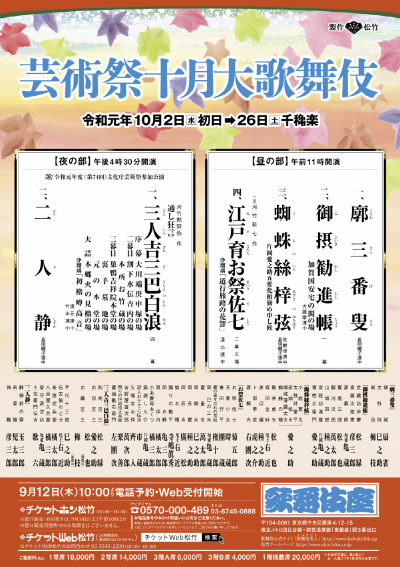 |
| National Theatre (T˘ky˘) |
| Dates | 2 ~ 26 October 2019 |
| Program | |
| Casting |
Living National Treasure Nakamura T˘z˘, Nakamura Shikan, Band˘ Yajűr˘, Nakamura Matagor˘, Ichikawa Komaz˘, Nakamura Matsue, Nakamura Kash˘, Nakamura Yonekichi, ďtani Hirotar˘, Nakamura Hashinosuke, Nakamura Tanenosuke, Nakamura Baika |
| Comments |
Revival at the National Theatre of Tsuruya Nanboku IV's masterpiece "Tenjiku Tokubŕ"!
|
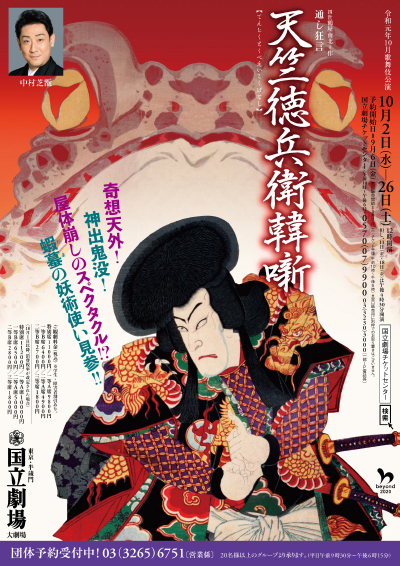 |
| Misonoza (Nagoya) |  |
| Dates | 2 ~ 26 October 2019 Kichirei Kaomise Annual Festive Face-Showing Program |
| MatinÚe |
|
| Evening | |
| Casting |
Living National Treasure Kataoka Nizaemon, Living National Treasure Kataoka Hidetar˘, Nakamura Baigyoku, Nakamura Jakuemon, Nakamura Ganjir˘, Kataoka Takatar˘, Nakamura Kinnosuke, Nakamura Shid˘ |
| Comments |
50th edition of the classic October kaomise programs in Nagoya.
|
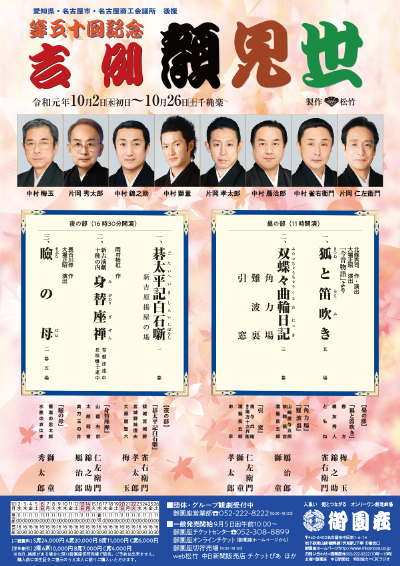 |
| Shinbashi Enbuj˘ (T˘ky˘) |  |
| Dates | 6 October ~ 25 November 2019 SűpÔ Kabuki Sekando Super Kabuki II |
| Program |
Shinpan Oguri |
| Casting |
Ichikawa Ennosuke, Nakamura Hayato, Band˘ Shingo, Ichikawa Monnosuke, Ichikawa Emisabur˘, Ichikawa Emiya, Ichikawa Omez˘, Ichikawa En'ya, Ichikawa Juen, Ichikawa K˘tar˘, Nakamura Fukunosuke, Ichimura Takematsu, Nakamura Tamatar˘, Ichikawa Otora, Ichikawa Ukon, Asano Kazuyuki, Kashima Noritoshi, Ishibashi Sh˘ji, Shimomura Ao, Ishiguro Hideo, Takahashi Y˘ |
| Comments |
The SűpÔ Kabuki Sekando drama "Shinpan Oguri" is a revised version of 1991 SűpÔ Kabuki drama "Oguri".
|
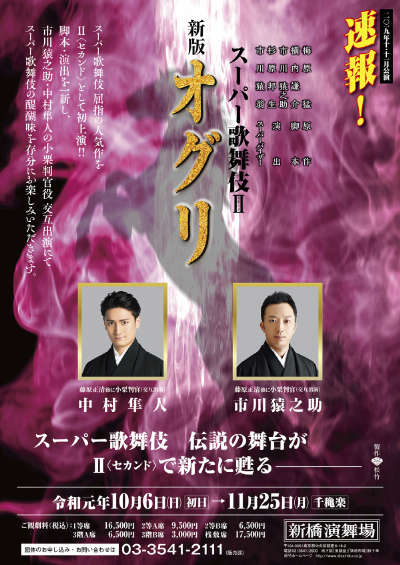 |
| Kinshű Special Tour | |
| Dates | 8 ~ 23 October 2019 |
| Program |
Geidan |
| Casting |
Nakamura Kankur˘, Nakamura Shichinosuke, Nakamura Tsurumatsu |
| Comments |
The word kinshű means "Autumn Brocade". This Autumn tour stars Nakamura Kankur˘ and Nakamura Shichinosuke. The first item in the program is a talk on stage. |
|
|||
| Dates | 30 October ~ 4 November 2019 Band˘ Tamasabur˘ Eiz˘ x Buy˘ K˘en Band˘ Tamasabur˘ Image and Dance Performances |
||
| Program |
Y˘kihi |
||
| Casting |
Living National Treasure Band˘ Tamasabur˘ |
||
| Comments |
A special Buy˘ program starring the amazing Living National Treasure onnagata Band˘ Tamasabur˘ in Yamaga at the Yachiyoza, a traditional wooden-built theater. There will be a mix of video projection (with video sequences coming from the high-quality Shinema Kabuki, "Cinema Kabuki") and real dancing on stage. |
||
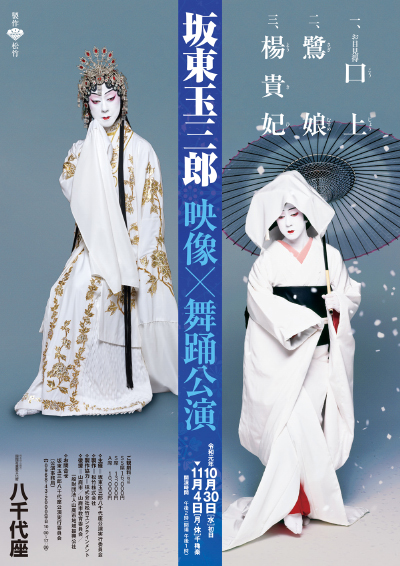 |
| T˘ky˘ (New National Theatre) | |
| Dates | 22 ~ 27 October 2019 |
| Program |
Nezumi Koz˘ Jirokichi |
| Casting |
Fujikawa Yanosuke, Kitazawa Kanami, Tadamura Shin'ya, Matsunami Kihachir˘, Hayase Einoj˘, Nakajima K˘tar˘, Yamamoto Harumi, Tamaura Yűnosuke, Yamazaki Tatsusabur˘, Matsuura Kainosuke |
| Comments |
Revival in T˘ky˘ at the New National Theatre of Mayama Seika's drama "Nezumi Koz˘ Jirokichi" based on the story of the thief Nakamura Jirokichi, commonly called Nezumi Koz˘. |
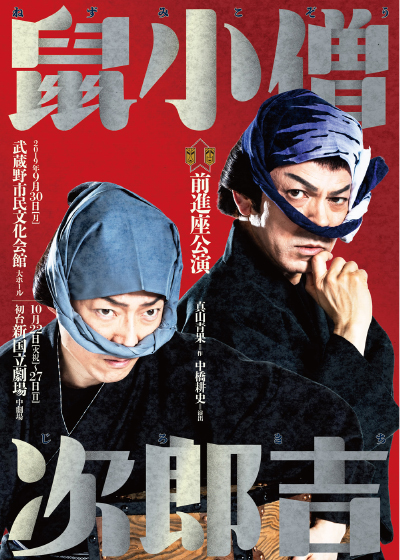 |
| National Theatre (T˘ky˘) |
| Dates | 28 October 2019 Nakamura Ky˘z˘ Buy˘ no Yűbe Evening for Dance by Nakamura Ky˘z˘ |
| Program |
Genzai D˘j˘ji |
| Casting | |
| Comments |
6th edition of the Buy˘ gala Nakamura Ky˘z˘ Buy˘ no Yűbe, dedicated this time to the legend of D˘j˘ji. |
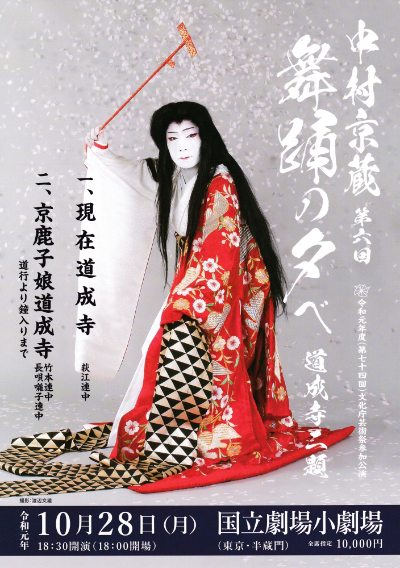 |
| Nagame Yoky˘j˘ (Midori) | |
| Dates | 14 October 2019 Yű no Kai |
| Program |
Hashire Merosu (story narrated on stage) Torisashi (suodori) Gekizaru (suodori) |
| Casting |
ďtani Keiz˘, ďtani Ryűsei |
| Comments |
1st edition of the Yű no Kai, a gala which stars ďtani Keiz˘ and his son ďtani Ryűsei, at the Nagame Yoky˘j˘ (Nagame Entertainment Theater), a traditional wooden-built theater (1937) in the city of Midori in Gunma Prefecture. |
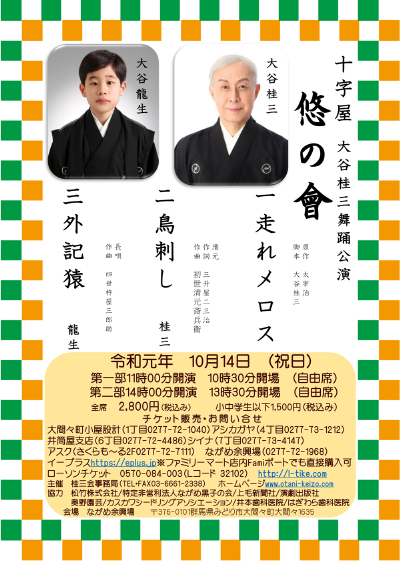 |
|
|||
| Dates | 30 October 2019 Seid˘kai |
||
| Program | |||
| Casting | |||
| Comments |
The 10th edition of the Seid˘kai, a gala for the Kiyomoto school of traditional music, at the Asakusa K˘kaid˘. The first item in the program is music only, performed by the music master Kiyomoto Enjudayű VII (father of Onoe Ukon) and his son Kiyomoto Saiju (brother of Onoe Ukon). The second item will be performed by both a Kiyomoto ensemble (led by Kiyomoto Shizuodayű and Kiyomoto Saiju) and by the actors Onoe Ukon and Nakamura Tanenosuke. |
||
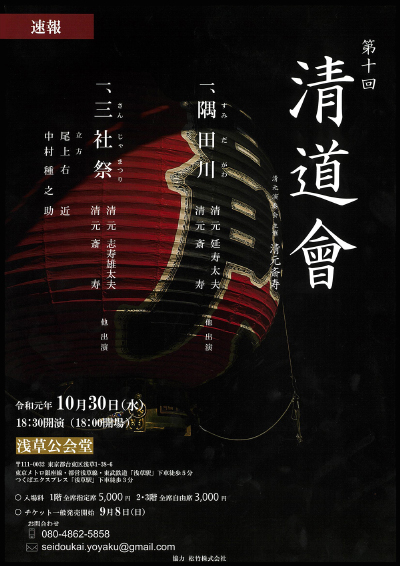 |
|
|
| Contact | Main | Top | Updates | Actors | Plays | Playwrights | Programs | Links | FAQ | Glossary | Chronology | Illustrations | Prints | Characters | Derivatives | Theaters | Coming soon | News |